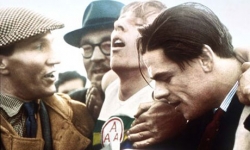How Bannister trained for and ran his sub-4 minute Mile

Progressive overload was achieved not by increasing the number of repetitions, nor by reducing the recovery, but rather more simply by incrementally increasing the speed of the reps.
By Tim Brennan & Matt Long, Athletics Weekly
Nearly 2,000 athletes have paid their own tribute to the great man by lacing up their trainers to take part in the BMC’s Bannister Virtual Mile Time Trials which concluded on May 6th. In 2016, BMC chair Tim Brennan was fortunate enough to be part of ‘An Audience with Sir Roger Bannister’. Four years later, it’s an evening in Reading that will live with him forever. Here he shares the late great man’s memories of that unforgettable day on May 6, 1954 on the Iffley Road track at Oxford.
A day at the office
On the day of the record attempt, Sir Roger went into his hospital laboratory which had a grindstone. Back in the 1950s, spikes were fixed to the running shoe and the aim was to give a sharp finish. With attention to detail, Sir Roger rubbed graphite into the spikes so that the cinders from the track would not stick to the shoe.
His travel to Oxford was by train and at this stage he was still in doubt as to whether the attempt should go ahead as weather conditions were decidedly windy and the thought was that conserving energies for more favorable conditions could be the right choice.
His charismatic coach Franz Stampfl was an exuberant character who implored him: “If you have a chance and don’t take it because of conditions you may never forgive yourself."
Eventually as he stared up from the changing room at the flag flying from the nearby church tower he felt that the wind was reducing and announced to his pacemakers that the attempt was on.
Four legendary laps
The gun went and as they completed the first lap Bannister recalled feeling “so easy”, as he called “faster, faster” to Chris Brasher who had the good sense to ignore him as they hit the quarter mile at 58 seconds. The pre-race target was sustained through the half mile at 1:58 before Chris Chataway took up the running and hit the three-quarter mile mark in 3:01.
Sensing the moment, with 260 yards to go Bannister strode out with the pain etched on his face as he forced himself through the remaining yards down the home straight feeling that the “tape was receding."
Sporting immortality
Once over the line, he had no idea if the attempt had been successful as he collapsed into the arms of his coach for what would be one of the sports’ most iconic and enduring images.
These were the days of pre-electronic timing and stopwatches had to be compared thus ensuring a wait ensued. The announcer, Norris McWhirter, milked the moment as the anticipation in the Oxford air was tangible: “The result of event 10, the one Mile.” … pause … “Is won by Roger Bannister of Merton and Exeter colleges” … pause … “In a time which subject to ratification is” … pause … “A new track, British, Commonwealth, European and world record” … pause … “Of three…” The rest was lost in the noise and excitement of the crowd, but the important digit was known. At long last a Mile had been won in three minutes-something.
When interviewed about the physiological underpinnings of his achievement, Sir Roger would famously say: “It’s the ability to take more out of yourself than you’ve got."
Psychology aside, Matt Long digs a little deeper into his training diaries.
Continue reading at: athleticsweekly.com
